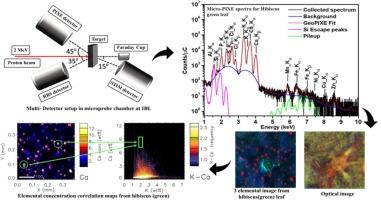Elucidating elemental mapping and their concentration correlation in unfixed aged leaves of Hibiscus Rosa-Sinensis and Azadirachta Indica
IF 1.4
3区 物理与天体物理
Q3 INSTRUMENTS & INSTRUMENTATION
Nuclear Instruments & Methods in Physics Research Section B-beam Interactions With Materials and Atoms
Pub Date : 2025-09-16
DOI:10.1016/j.nimb.2025.165868
引用次数: 0
Abstract
Particle Induced X-Ray Emission Spectroscopy (PIXE) using scanning proton microbeam was used to investigate elemental concentration mapping and the correlation between the concentration of macro and micro-elements at significant regions of interest in Hibiscus (Hibiscus rosa-sinensis) and Neem (Azadirachta indica) leaves. These plants are widely studied medicinal plants used for their healing properties in both traditional and modern practices. The detected elements in all leaves included macro-elements such as Al, Si, P, S, Cl, K, and Ca, as well as micro-elements like Sc, Ti, Mn, Fe, Co, Ni, Cu, and Zn. A focused study on the different color leaves of the hibiscus was carried out to distinguish between the distribution of elements with aging. Aged hibiscus leaf was also found to accumulate heavier elements such as S, Cl, and Ca and be deficient in Fe, leading to toxicity and yellowing. Moreover, an aged neem leaf showed high amounts of Si, K, Ca, and Fe, showing good retention of elements even with low cellular processes and nutritional transport.

木槿和印楝未固定老化叶片中元素定位及其浓度相关性研究
利用扫描质子微束粒子诱导x射线发射光谱(PIXE)研究了木芙蓉和印楝叶片中元素浓度映射及显著区常量和微量元素浓度的相关性。这些植物被广泛研究药用植物,用于传统和现代实践的治疗特性。所有叶片中检测到的元素包括Al、Si、P、S、Cl、K、Ca等宏量元素和Sc、Ti、Mn、Fe、Co、Ni、Cu、Zn等微量元素。对木槿不同颜色叶片进行了重点研究,以区分不同颜色叶片中元素随衰老的分布。陈年木槿叶还积累了较重的元素,如S、Cl和Ca,并缺乏铁,导致毒性和发黄。此外,老化的楝叶显示出大量的Si, K, Ca和Fe,即使在低细胞过程和营养运输中也表现出良好的元素保留。
本文章由计算机程序翻译,如有差异,请以英文原文为准。
求助全文
约1分钟内获得全文
求助全文
来源期刊
CiteScore
2.80
自引率
7.70%
发文量
231
审稿时长
1.9 months
期刊介绍:
Section B of Nuclear Instruments and Methods in Physics Research covers all aspects of the interaction of energetic beams with atoms, molecules and aggregate forms of matter. This includes ion beam analysis and ion beam modification of materials as well as basic data of importance for these studies. Topics of general interest include: atomic collisions in solids, particle channelling, all aspects of collision cascades, the modification of materials by energetic beams, ion implantation, irradiation - induced changes in materials, the physics and chemistry of beam interactions and the analysis of materials by all forms of energetic radiation. Modification by ion, laser and electron beams for the study of electronic materials, metals, ceramics, insulators, polymers and other important and new materials systems are included. Related studies, such as the application of ion beam analysis to biological, archaeological and geological samples as well as applications to solve problems in planetary science are also welcome. Energetic beams of interest include atomic and molecular ions, neutrons, positrons and muons, plasmas directed at surfaces, electron and photon beams, including laser treated surfaces and studies of solids by photon radiation from rotating anodes, synchrotrons, etc. In addition, the interaction between various forms of radiation and radiation-induced deposition processes are relevant.

 求助内容:
求助内容: 应助结果提醒方式:
应助结果提醒方式:


